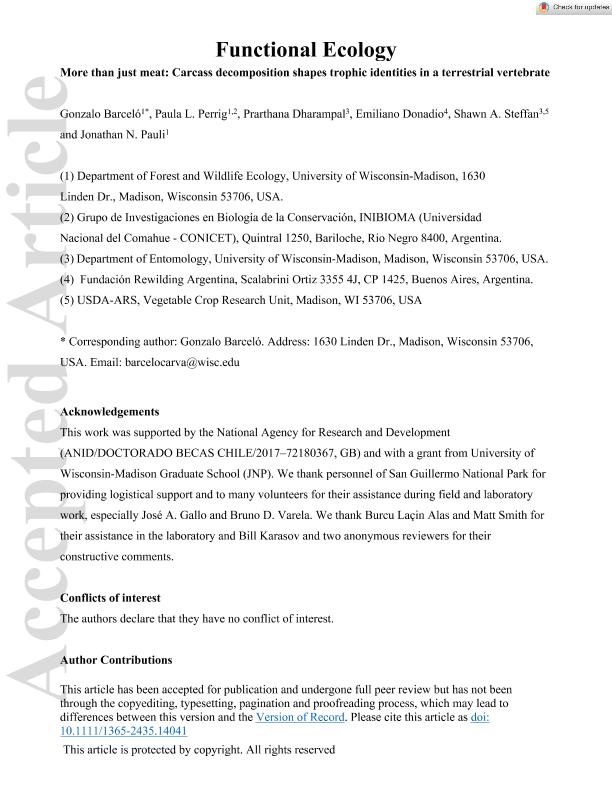Artículo
More than just meat: Carcass decomposition shapes trophic identities in a terrestrial vertebrate
Barceló, Gonzalo; Perrig, Paula Leticia ; Dharampal, Prarthana; Donadio, Emiliano
; Dharampal, Prarthana; Donadio, Emiliano ; Steffan, Shawn A.; Pauli, Jonathan Nicholas
; Steffan, Shawn A.; Pauli, Jonathan Nicholas
 ; Dharampal, Prarthana; Donadio, Emiliano
; Dharampal, Prarthana; Donadio, Emiliano ; Steffan, Shawn A.; Pauli, Jonathan Nicholas
; Steffan, Shawn A.; Pauli, Jonathan Nicholas
Fecha de publicación:
03/2022
Editorial:
Wiley Blackwell Publishing, Inc
Revista:
Functional Ecology
ISSN:
0269-8463
Idioma:
Inglés
Tipo de recurso:
Artículo publicado
Clasificación temática:
Resumen
Most food web models fail to account for the full complexity of interactions within a community, particularly where microbes are involved. Carcasses are microbe-rich resources and may represent a common nexus for the macrobiome and microbiome, effectively uniting autotrophs, consumers, predators and microbiota. We evaluated the role of carcasses as multitrophic resources and explored dietary partitioning for a sexually dimorphic obligate scavenger known for its hierarchical social system. This study was set in a well-studied community of camelids Vicugna, Lama guanicoe, pumas Puma concolor and Andean condors Vultur gryphus in the Andes. We hypothesized that condors, by feeding on trophically distinct dietary substrates within any given carcass, would have highly variable trophic position (TP) values. Furthermore, we expected that the microbial consumers within the carcass would inflate TP values in both, the carrion and the condors. Thus, we expected that the trophic heterogeneity within a carcass could facilitate sex-based dietary partitioning in condors. We used a multifaceted approach to assess the foraging of Andean condors, using regurgitated pellet and bulk isotopic analyses, and also quantified the TP of the entire community of graminoids, camelids, camelid carrion, pumas, and female and male condors employing compound-specific stable isotopes analysis of amino acids. Our analysis of condor pellets and bulk isotopes revealed non-trivial plant consumption, close to 10% of condor diet. Isotope analysis of amino acids revealed that condors had highly variable TPs (2.9 ± 0.3) compared to pumas (3.0 ± 0.0) and camelids (2.0 ± 0.1), likely representing ‘trophic omnivory’, wherein the condors consume plants (TP = 1.0 ± 0.1) and microbe-colonized carrion (2.3 ± 0.1). Female condors exhibited a TP (2.8 ± 0.2) lower than strict carnivory, suggesting that they consume more plant biomass in a carcass, while males (TP = 3.1 ± 0.3) are likely consuming more of the microbe-rich animal tissue. Our study highlights that carcasses represent a trophically heterogeneous resource and that vertebrate scavengers can feed across trophic groups within the carcass, from autotrophs to secondary consumers, and from both the macrobiome and microbiome. Thus, integration of microbes in macroecological contexts can help to resolve trophic identity, and better characterize the importance of microbes in detritivorous and omnivorous species. Read the free Plain Language Summary for this article on the Journal blog.
Palabras clave:
CARRION
,
DETRITIVORY
,
FOOD WEBS
,
GUANACO
,
MICROBE
,
NECROBIOME
,
OMNIVORE
,
VULTURE
Archivos asociados
Licencia
Identificadores
Colecciones
Articulos(INIBIOMA)
Articulos de INST. DE INVEST.EN BIODIVERSIDAD Y MEDIOAMBIENTE
Articulos de INST. DE INVEST.EN BIODIVERSIDAD Y MEDIOAMBIENTE
Citación
Barceló, Gonzalo; Perrig, Paula Leticia; Dharampal, Prarthana; Donadio, Emiliano; Steffan, Shawn A.; et al.; More than just meat: Carcass decomposition shapes trophic identities in a terrestrial vertebrate; Wiley Blackwell Publishing, Inc; Functional Ecology; 36; 6; 3-2022; 1473-1482
Compartir
Altmétricas



